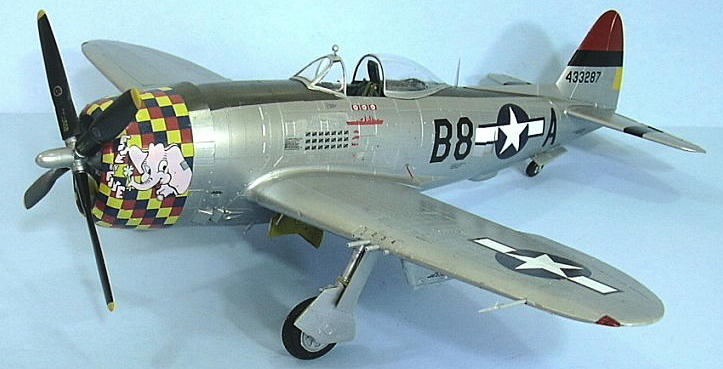
Trumpeter 1/32 P-47D-30 Thunderbolt
| KIT #: | 2264 |
| PRICE: | $140.00 MSRP |
| DECALS: | Two options |
| REVIEWER: | Tom Cleaver |
| NOTES: | 'Dorsal Fin' boxing |

| HISTORY |
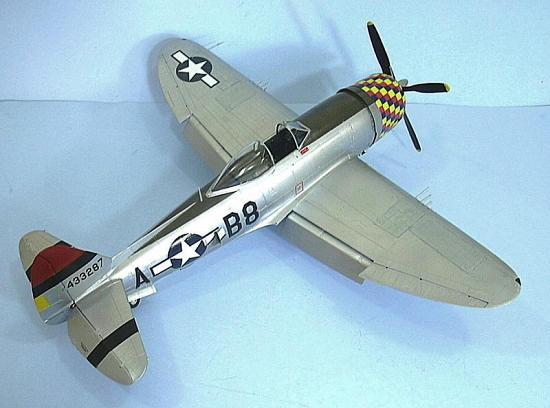 The Seversky P-35 and Republic P-43 ancestors of the Thunderbolt were
distinguished by their exceptional range in comparison with their
contemporaries. The Thunderbolt, however, was designed as a short-range
interceptor, and was forced to become a long-range escort fighter when the
concept of the self-defending daylight bomber formation was smashed against the
Luftwaffe over Germany in 1943. Even carrying drop tanks on three pylons, the
Thunderbolt was hard-pressed to make it all the way to Berlin, and if the
Germans attacked early, forcing the escorts to drop tanks and enter combat, the
bombers continued to suffer from lack of adequate long-range escorts. However,
the Thunderbolt acquitted itself far better in aerial combat than anyone had
originally expected.
The Seversky P-35 and Republic P-43 ancestors of the Thunderbolt were
distinguished by their exceptional range in comparison with their
contemporaries. The Thunderbolt, however, was designed as a short-range
interceptor, and was forced to become a long-range escort fighter when the
concept of the self-defending daylight bomber formation was smashed against the
Luftwaffe over Germany in 1943. Even carrying drop tanks on three pylons, the
Thunderbolt was hard-pressed to make it all the way to Berlin, and if the
Germans attacked early, forcing the escorts to drop tanks and enter combat, the
bombers continued to suffer from lack of adequate long-range escorts. However,
the Thunderbolt acquitted itself far better in aerial combat than anyone had
originally expected.
When the Thunderbolt went into combat with the Ninth Air Force in the
ground support role, its heavy armament and ability to take hits that would down
another aircraft and keep flying, turned the P-47 into the "juggernaut" it was
originally claimed to be merely by its size
Col. Joe Laughlin and the 362nd
Fighter Group:
Joseph L. Laughlin joined the USAAC in 1939 and received his wings and
commission in June 1940, and was assigned to the 14th Pursuit Squadron at
Wheeler Field, Hawaii that September.
Following the attack on Pearl Harbor, Laughlin flew a 350-hour combat
tour against the Japanese in the Central Pacific, ending his tour as CO, 45th
FS, 18th FG. He returned to the US in the fall of 19433 and took command of the
newly-formed 379th FS, 362nd FG.
Known as "Mogin's Maulers" in tribute to their commander Col. "Mogin"
Magoffin, the 362nd FG arrived in England at the end of November
1943. They received their first P-47 Thunderbolts on December 29, 1943. Once
fully operational in mid-February 1944, the 362nd FG began flying
escort missions with the 8th Air Force during the latter stages of
the action known as “Big Week.” ,
the Group cut its combat teeth escorting bombers of the Eighth Air Force on
their missions over the Continent.
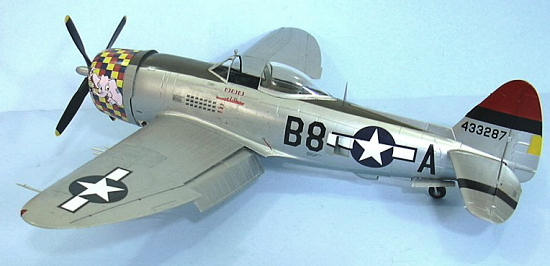 The 362nd FG was awarded their first of two Distinguished Unit
Citations (DUC) for action on August 25, 1944 when they attacked targets in
Brest harbor, in which direct hits were scored on two cruisers, one of which was
left beached and burning. Col. Laughlin - who had just assumed command of the
group following the loss of Col. Magoffin to flak on August 19 - gained the
distinction of being the only USAAF fighter pilot in the ETO to be credited with
having sunk a capital German warship. Additionally, 12 naval and merchant
vessels engaged in troop evacuation were damaged severely. Although the primary
assignment of the 362nd FG was close air support, they were credited
with shooting down 137 German
aircraft. Their work over the
Continent following the invasion cost 97 pilots killed or captured.
The 362nd FG was awarded their first of two Distinguished Unit
Citations (DUC) for action on August 25, 1944 when they attacked targets in
Brest harbor, in which direct hits were scored on two cruisers, one of which was
left beached and burning. Col. Laughlin - who had just assumed command of the
group following the loss of Col. Magoffin to flak on August 19 - gained the
distinction of being the only USAAF fighter pilot in the ETO to be credited with
having sunk a capital German warship. Additionally, 12 naval and merchant
vessels engaged in troop evacuation were damaged severely. Although the primary
assignment of the 362nd FG was close air support, they were credited
with shooting down 137 German
aircraft. Their work over the
Continent following the invasion cost 97 pilots killed or captured.
The 362nd FG was fortunate to have among its assigned pilots one George
Rarey, called "Dad" by the other pilots due to his having reached the advanced
age of 25 when he joined the USAAF in 1942. A successful commercial artist
before the war, Rarey was responsible for the group's nose-art from their
arrival in England in November 1943 until his death in combat in June 1944.
Following Rarey's death, his role as Group Artist was undertaken by his former crew chief, who maintained Rarey's distinctive style. P-47D-30-RA, 44-33287, was the last of 12 P-47s flown by Colonel Laughlin, all named "Five-by-Five," and all carrying Rarey's distinctive painting of a pink elephant.
| THE KIT |
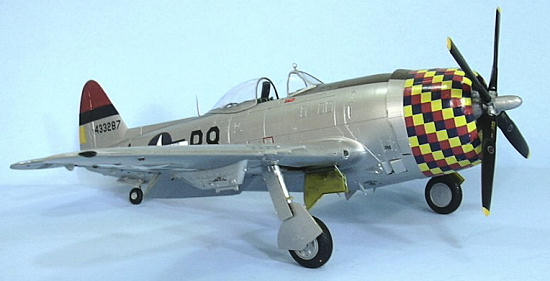 This late-model P-47D-30 is the fourth, and last, of Trumpeter’s 1/32
Thunderbolts. It differs primarily
from the first bubble-top kit in having a separate vertical fin part that
includes the dorsal fin extension that is the primary visual difference between
the early and late-production Thunderbolts.
Otherwise, this kit is the same as the earlier one.
This late-model P-47D-30 is the fourth, and last, of Trumpeter’s 1/32
Thunderbolts. It differs primarily
from the first bubble-top kit in having a separate vertical fin part that
includes the dorsal fin extension that is the primary visual difference between
the early and late-production Thunderbolts.
Otherwise, this kit is the same as the earlier one.
Unfortunately, the kit provides only the corrugated cockpit floor
appropriate to the P-47D-25. A
modeler for whom this is a real sticking point could replace the cockpit floor
with a scratchbuilt floor done with Evergreen sheet.
The kit provides decals for two aircraft, including “Five-by-Five,” in
her final markings. Unfortunately,
Trumpeter continues to have difficulty reproducing the U.S. National Insignia in
its proper dimensions, so a modeler must obtain suitable aftermarket decals to
take care of these.
| CONSTRUCTION |
Construction is the exact same as the other Trumpeter P-47 kits, with the
exception that I finally discovered why I had a problem with “sink” when
attaching the ammo bay doors to the upper wing.
The structure inside the ammo bay does not extend up high enough for the
door to rest on it, so it will drop down while setting up.
I found that if I put a piece of .010 Evergreen sheet about 3/8 inch by
1.5 inch inside the ammo bay door, it would then sit right and there would be no
sink.
I used Eduard 1/32 US late style seat belts, which really make the
cockpit look good.
| COLORS & MARKINGS |
Painting:
It being too cold here in Los Angeles this past week to go outside and
airbrush with lacquer-base paint (one would take one’s life in their hands to
attempt such a thing inside with the windows closed - this is a Major SWMBO
No-Never here at Le Chateau du Chat), and having discovered that the Talon
paints had started to harden up due to lack of recent use, I was in need of
finding quick access to an acrylic metalizer paint.
I was fortunate to have the airbrushing expert at my local artist’s
supply store point me to Auto-Air acrylic paints.
What was to dislike? Twice
as much paint for the same price as a bottle of Alclad!
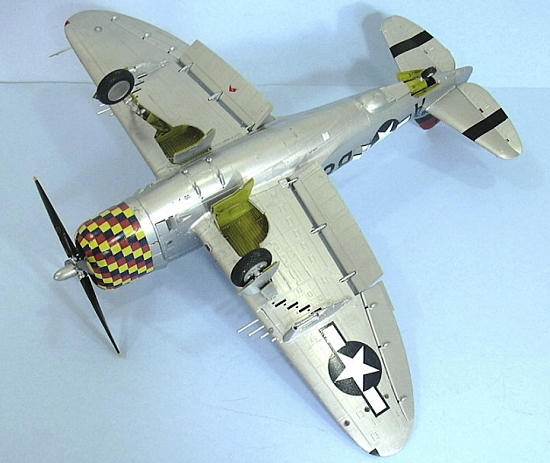 The color is wonderful - it looks just like Alclad “Duraluminum” when
applied. It is the easiest acrylic
paint I have ever applied - the instructions say thin 2:1 which works just fine
if you shoot at 30 psi. Mist
it on as they say and in about five passes it will be done.
The color is wonderful - it looks just like Alclad “Duraluminum” when
applied. It is the easiest acrylic
paint I have ever applied - the instructions say thin 2:1 which works just fine
if you shoot at 30 psi. Mist
it on as they say and in about five passes it will be done.
That said, this paint is fragile.
You must apply a primer coat for it to grab on.
I found that the best primer coat is Tamiya Flat Aluminum.
If you use this, the metalizer paint will cover in only a few light
coats. If it comes off while you
are handling it before you apply a sealer, it will not be apparent.
The paint also needs a sealer, and I found that Model-Master Metalizer
Thinner worked just fine. The good
news here is that the metalizer paint does not lose its sheen when it is sealed,
as Model Master Metalizer paints do.
The paint cannot be masked over with any low-tack tape.
You can “mask” areas using wet newspaper, an old trick I learned back in
the MM Metalizer days. However, if
you use other shades of the metal paint and apply it thinned 1:1 with a brush,
it will dry without brush strokes.
All that said, I have found it’s a good idea with Talon metalizers to
also treat them carefully when it comes to handling, since Talon will also wear
off leading and trailing edges, as the Auto-Air will do.
I long ago got in the habit if picking up models painted with Metalizer
paints (other than Alclad) by the area painted some other color.
While Alclad is the gold standard for toughness, there is no fear with
Auto-Air of your model being eaten by the paint.
But a good well-cured coat of Tamiya Flat Aluminum underneath will go far
to solving most of the fragility problems I have described here.
The Auto-air paint should also cure in a warm environment.
Decals:
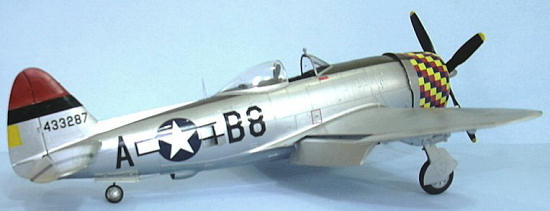 As mentioned, the kit decals for the National Insignia are worthless.
I used national insignia from a Cutting Edge 1/32 P-47 sheet.
The rest of the decals are thin and go on easily.
The big checkerboard decals for the cowling can go on in two large
pieces, but I suggest (from experience) that you cut them in strips, apply each
and get it down fully, then apply the next.
Do not be afraid of using too much water to get them in position.
The colors of the checkerboard are suspect - the red should be more red
and the blue should be lighter, but there are no alternative decals and I’m not
about to paint and mask something like that.
As mentioned, the kit decals for the National Insignia are worthless.
I used national insignia from a Cutting Edge 1/32 P-47 sheet.
The rest of the decals are thin and go on easily.
The big checkerboard decals for the cowling can go on in two large
pieces, but I suggest (from experience) that you cut them in strips, apply each
and get it down fully, then apply the next.
Do not be afraid of using too much water to get them in position.
The colors of the checkerboard are suspect - the red should be more red
and the blue should be lighter, but there are no alternative decals and I’m not
about to paint and mask something like that.
| FINAL CONSTRUCTION |
I attached the landing gear and prop, and unmasked the canopy and
attached it in the open position.
| CONCLUSIONS |
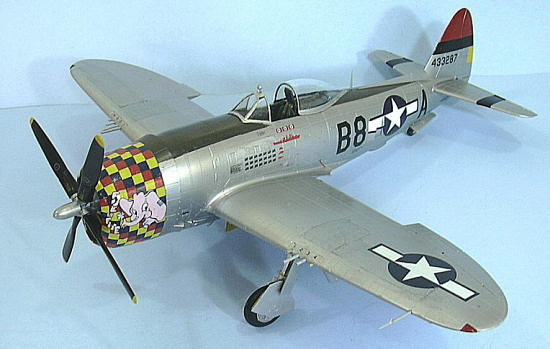 Now that the Hasegawa P-47 kit is selling for around $80 retail, the
price differential between it and these Trumpeter kits is not so much that price
is the sole determinant. I like the
Trumpeter kit’s additional detail - the excellent engine, the posable control
surfaces, etc. The Hasegawa bubble
canopy is more accurate in profile, but this is only noticeable if you have the
two kits next to each other and a photo to refer to (which I did, which is how I
happened to notice this), but it looks good otherwise.
The Trumpeter kit has all the under wing ordnance and every drop tank
ever used by a P-47, and their props look better than the Hasegawa offerings.
The rivet detail on the Trumpeter kit does not look that bad to me under
the proverbial “coat of paint.”
Now that the Hasegawa P-47 kit is selling for around $80 retail, the
price differential between it and these Trumpeter kits is not so much that price
is the sole determinant. I like the
Trumpeter kit’s additional detail - the excellent engine, the posable control
surfaces, etc. The Hasegawa bubble
canopy is more accurate in profile, but this is only noticeable if you have the
two kits next to each other and a photo to refer to (which I did, which is how I
happened to notice this), but it looks good otherwise.
The Trumpeter kit has all the under wing ordnance and every drop tank
ever used by a P-47, and their props look better than the Hasegawa offerings.
The rivet detail on the Trumpeter kit does not look that bad to me under
the proverbial “coat of paint.”
These Trumpeter P-47s make up into a very good model, and I recommend
them to any modeler other than an absolute novice.
Review kit courtesy of Stevens International.
If you would like your product reviewed fairly and quickly, please contact me or see other details in the Note to Contributors.